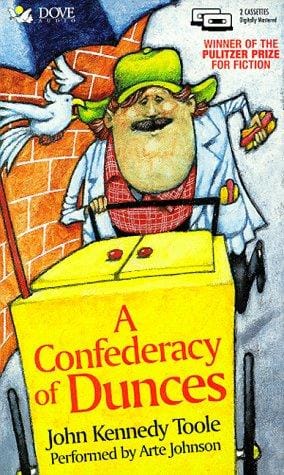Exploring “A Confederacy of Dunces”: Plot, Themes, and Lasting Legacy

Introduction to A Confederacy of Dunces
John Kennedy Toole’s A Confederacy of Dunces is an American comic masterpiece that won the Pulitzer Prize for Fiction in 1981. Set against the colorful backdrop of 1960s New Orleans, the novel follows the misadventures of Ignatius J. Reilly, a bombastic, larger-than-life protagonist whose eccentric worldview collides with modern society. This article delivers an SEO-friendly deep dive into the plot, characters, themes, and cultural impact of A Confederacy of Dunces, revealing why the book remains essential reading for lovers of Southern literature and satirical fiction.
Plot Overview
The story begins with Ignatius waiting beneath the iconic clock of the D. H. Holmes department store, clad in a green hunting cap and voluminous plaid trousers. After a scuffle with Officer Mancuso, Ignatius is forced to seek gainful employment—an undertaking wholly repugnant to his medieval sensibilities. His ill-fated jobs include pushing a hot-dog cart for Paradise Vendors and working as a file clerk at Levy Pants. Each position ends disastrously, thanks to Ignatius’s grandiose schemes and total lack of self-awareness.
Parallel story lines follow a colorful ensemble of New Orleans characters: Irene Reilly, Ignatius’s long-suffering mother; Myrna Minkoff, his militant ex-classmate from New York; Burma Jones, an underpaid janitor at the Night of Joy bar; Lana Lee, the bar’s crooked proprietor; and the Levys, a dysfunctional couple running the failing Levy Pants factory. Toole weaves these narratives into a farcical crescendo, culminating in a chaotic parade mishap, an attempted workers’ revolt, and Ignatius’s ultimate flight from the city with Myrna, who arrives like a deus ex machina to rescue him from the threat of institutionalization.
Main Characters
Ignatius J. Reilly
Ignatius is a thirty-year-old medievalist who brandishes a Big Chief tablet for his philosophical musings. He condemns pop culture, technology, and capitalism but displays immense sloth and gluttony, consuming vats of Dr. Nut soda and Paradise hot dogs. His bombastic rhetoric and hilarious hypocrisy make him one of the most unforgettable characters in American literature.
Irene Reilly
Ignatius’s widowed mother seeks companionship and financial security, often clashing with her son’s indolence. Her car accident with a streetcar propels the plot by saddling the Reillys with debt, forcing Ignatius into the workforce.
Myrna Minkoff
Representing liberal activism, Myrna constantly challenges Ignatius via fiery letters. Their intellectual rivalry masks a romantic undertone, culminating in her arrival to whisk Ignatius away in the novel’s final scene.
Burma Jones
Jones is an African-American janitor employed at exploitative wages by Lana Lee. His sardonic observations on race and labor add depth to the novel’s social satire.
Lana Lee
The villainous nightclub owner runs a pornography ring while exploiting her workers. Her eventual arrest provides cathartic justice in this carnivalesque narrative.
Major Themes
Satire of Modern Society
Toole lampoons consumerism, bureaucracy, and social injustice. Ignatius’s antiquated worldview contrasts absurdly with the superficial modern world, exposing hypocrisy on all sides.
Alienation and Isolation
Every character, from Ignatius to Officer Mancuso, battles loneliness and yearns for validation. The novel suggests that community arises not from conformity but from shared eccentricity.
Class and Labor
Levy Pants, Paradise Vendors, and the Night of Joy represent exploitative labor conditions. Through humor, Toole critiques wage slavery and corporate indifference, themes still resonant in today’s gig economy.
Fate and Free Will
The dense network of coincidences—broken glass, lost parrots, runaway hot-dog carts—echoes classical comedy. Yet Ignatius remains convinced of Fortuna’s wheel, blaming cosmic forces rather than his own folly.
Why Read A Confederacy of Dunces Today?
Despite being penned in the early 1960s, the book’s commentary on consumer culture, political division, and generational conflict feels strikingly current. Toole’s pitch-perfect ear for dialect immerses readers in New Orleans’ French Quarter, while his comedic timing rivals P. G. Wodehouse and Evelyn Waugh. For anyone seeking a novel that balances laugh-out-loud moments with incisive social critique, A Confederacy of Dunces is unmatched.
Cultural Impact
Since its posthumous publication in 1980—championed by writer Walker Percy—the novel has sold millions of copies worldwide. It revitalized interest in Southern Gothic comedy and inspired articles, academic studies, and fan pilgrimages to Ignatius’s haunts in New Orleans. The bronze statue of Ignatius J. Reilly on Canal Street attests to the character’s enduring presence in the city’s folklore.
Adaptations and Unfulfilled Film Projects
Hollywood has long courted Ignatius, yet film adaptations remain cursed. Notable attempts involved John Belushi, John Candy, and Chris Farley, each ending after the actors’ untimely deaths. Directors such as Steven Soderbergh and David Gordon Green have circulated scripts, but no project has escaped “Development Hell.” This failure underscores the difficulty of translating Toole’s interior monologues and sprawling cast to the screen.
Legacy of John Kennedy Toole
Tragically, Toole committed suicide in 1969, believing his work a failure after repeated rejections. His mother, Thelma Toole, tirelessly campaigned to publish the manuscript, convincing Walker Percy to read it. The novel’s eventual Pulitzer win stands as both a literary triumph and a poignant reminder of unrealized potential. Toole’s personal story adds a layer of pathos that enriches the reading experience.
Visiting New Orleans Through the Novel
Readers and tourists can trace Ignatius’s steps from the former D. H. Holmes (now the Hyatt Centric Hotel) to the French Market and Canal Street. Literary walking tours showcase the city’s vibrant culture—beignets at Café du Monde, jazz floating from Preservation Hall, and the wrought-iron balconies of the Quarter—all elements that infuse Toole’s narrative with authenticity.
Conclusion
A Confederacy of Dunces endures because it captures humanity’s absurdities with warmth, wit, and unflinching honesty. Whether you are a first-time visitor to New Orleans literature or revisiting an old favorite, Ignatius J. Reilly’s chaotic pilgrimage promises both laughter and insight. Pick up a copy, laugh at the lunacy, and perhaps glimpse your own foibles reflected in Toole’s confederacy of unforgettable dunces.